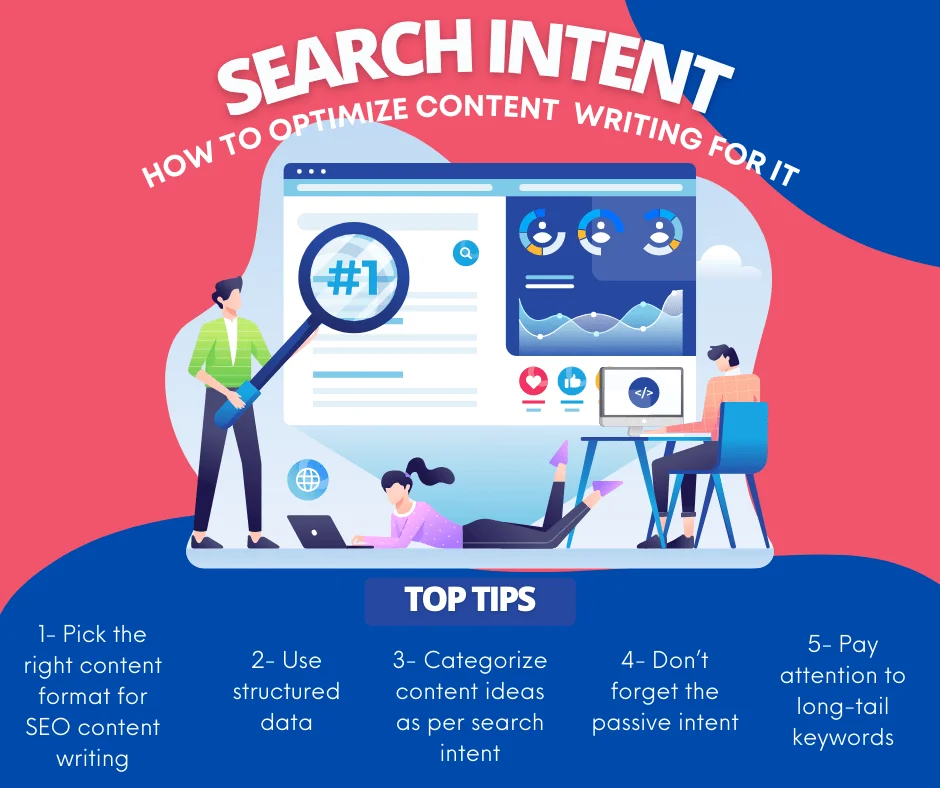Have you Googled a particular query and ever got a wrong answer?
Chances are – Never!
Well, this is the power of search intent that Google uses as an important ranking factor.
Search intent has become an important aspect of SEO. This is one of the reasons why experts request content writers to create content that either supports or agrees with the user’s search intent. No wonder that search intent makes it to our list of the reasons to hire a content writer in 2022.
Gone are days when you were only required to focus on keywords to climb the search engine result page’s (SERPs) ladder. Nowadays, addressing what the users type in the search engines and why, matters too.
In short, you need to optimize your content as per the search intent. But how would you do so? Dive into this blog to find your answer.
What is search intent in SEO content writing?
Sometimes also referred to as user intent, search intent essentially means figuring out the reason or goal behind a person’s query that he/she enters in the search engine.
Every search made on the internet has a reason behind it – whether it is to find answers, to purchase items, or just to learn about something.
If you can understand the goal, objective, or intent of the users when they use certain phrases or keywords and use the information while creating the content, you can make your landing page or website get ranked for those keywords users are searching for.
Why is search intent so important?
As we read above, optimizing content for user intent directly impacts the rankings. This means you will increase your website’s chance of being visible on the first page, attract visitors and eventually make more sales.
Search engines have been striving hard to evolve their algorithms to identify the search intent of the users. And are adamant about ranking only those pages that best fit the search term or intent of the user. This is why it is important to match the search intent of your users with the content of your page.
Four types of search intent
To understand how the search intent works, it is important to identify the four types of user intent first.
1- Navigational search intent
Navigational search intent is when a user is looking for a specific web page but has no idea of what the exact URL is. So, they use search engines to find the particular page. For instance, a user typing “YouTube” in the Google search engine instead of visiting the official site directly.
2- Informational search intent
Informational search intent is when a user is looking for details on a certain topic that is non-commercial. You must keep in mind that not all the informational search intent is formulated as questions. Searching case results and news updates are some classic examples.
3- Commercial search intent
Commercial search intent is searches made to buy in the long run. Even though these searches aren’t directly transactional, but can result in either exchange of money or goods down the line. Anyone conducting such searches is likely checking the available options and is looking for reviews and more information on the product.
For instance –
- Samsung latest phone
- Latest clothing style of 2022, etc.
4- Transactional search intent
A transactional search is done when an individual is looking forward to doing business. Similar to commercial, this type of search intent also results in an exchange of goods and money, but on the spot. Popular keywords or search terms you will come across will contain words like –
- Price of (name/model of the phone)
- (Name/model of the phone) + price (of the product)
- Purchase
- Order, etc.
Top ways to optimize content writing for search intent
With proper search intent optimization, you can put your content in front of the searchers who are in need of the information you have to provide and stay ahead of your competition.
Here are some smart ways of achieving search intent optimization.
1- Pick the right content format for SEO content writing
When it comes to content consumption, not every reader likes the same content in the same way. So, the first thing you need to do is choose the right content format.
With the right content format, you can make it possible for the readers to navigate through and even share it easily, hence, maximizing the reach of your content.
For instance, if your readers love the Q&A type of format, start requesting the customers to raise questions so you can answer the common and popular ones to drive more traffic to your site.
Plus, an SEO blog writer can repurpose a content piece to different content formats.
For example, she can repurpose a blog to a PPT slideshow, a YouTube video, an infographic, or podcast
2- Employ structured data
Apart from adding relevant and informative content, you have to ensure they are properly structured. This way, you will enable the search engine spiders to crawl through your site efficiently to index and provide informative snippets for the searches.
You can employ schema.org to structure data and make it suitable for the appearance in Google search and even reassure that the data is what it claims to be.

3- Categorize the content ideas as per search intent
While keyword research is a crucial content writing service there is another vital requirement.
You need to map your content ideas and categorize them as per search intent.
This way, you can identify well dispersed your content is.
For example, posting informational content is great to attract traffic to the page, but it can take a long time to convert into customers. You might want to focus on commercial intent-driven content, too.
It is best to keep things organized, preferably on a spreadsheet, to have a bigger picture perspective and keep things organized.
4- Don’t forget the passive intent in content writing services
Do you ever come across additional links while reading a particular blog or article on a website? Well, these additional contents are passive or secondary intent from the query.
The notion is to think more than what the user is searching for.
For example, consider that the user is searching for “car maintenance services.” You might want to add information about “car washing services,” too – a logical next step. Article writers use these to expand the scope of information/education provided by the content.
5- Pay attention to long-tail keywords
Did you know that more than 70% of users search with a long-tail keyword? This should be a valuable guidance for SEO content writers.
A search query with more than three words is a long-tail keyword with low search volume and competition. Using it can help you attract highly-focused traffic to the site.
For instance, “content writing company near me” is a good example of a long-tail keyword.
Learn More – How to Get the Best Long-Tail Keywords for Your Next Blog?
Wrapping up
Search engines care more about the user experience than you or your website. They scan through thousands of websites only to display ones that best cover the topic a user is searching for.
Use this blog as a guide to properly optimize your content for search intent and eventually rank higher on SERPs.
Get high-quality content writing services with Textuar. Our agency can deliver content that closely matches your target readers’ search intent.











